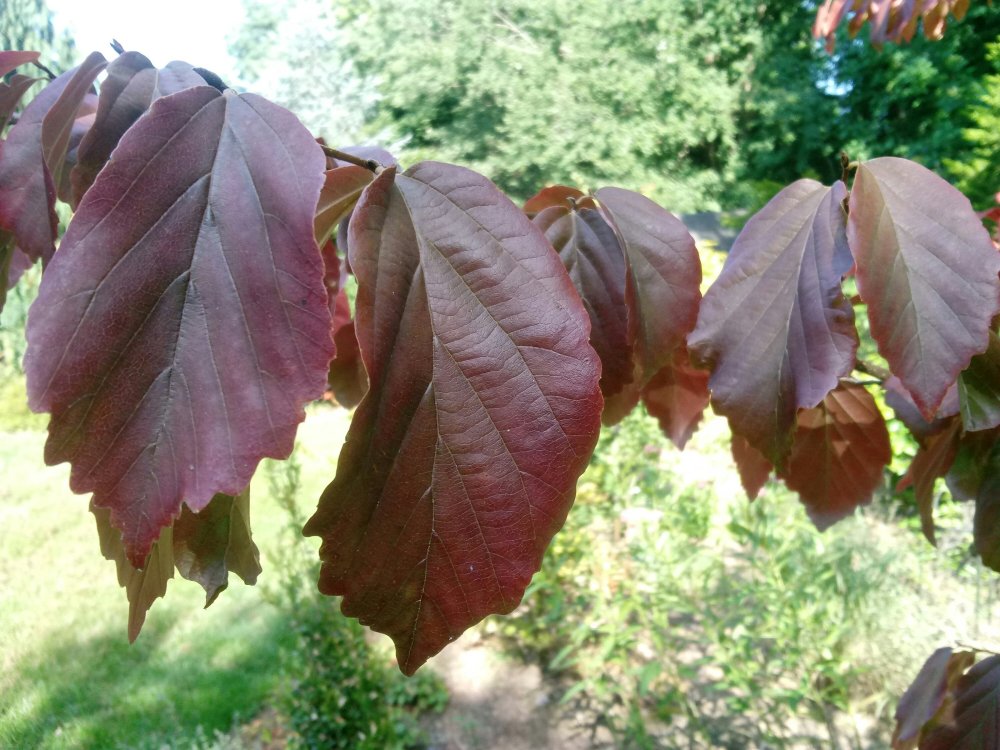A considerable number of plants were transplanted in late winter. Expanded planting beds in the rear garden, and cutting into the already small section of lawn irked my wife, though I believe that now she approves of the new plantings (of course, she refuses to admit it). All plants that were moved are doing well, or well enough, though leaves of the Persian ironwood (Parrotia persica, below) have been red for weeks.
This is a bit concerning, certainly a sign of stress, though it is encouraging that no leaves are dropping. Perhaps the stress is related to the deluge of rainfall through May and June, and less to do with the transplant that was accomplished in early February with a five inch deep freeze in the ground. The giant ice cube (the tree) was moved from a spot that was far too shady, where it was once planted for lack of a better place, into an area of nearly full sun that should be more ideal, with the additional purpose that it would soon shade an Autumn Full Moon Japanese maple that has struggled and would never thrive in the summer sun.
A tree peony, catmints, and native carex were planted on the side of the ironwood that will turn eventually from full sun to part shade, and a small, red flowered paperbush (Edgeworthia chrysantha ‘Akebono’) was planted on the side that will remain sunny. I’ve been tempted to fill open spaces beside the paperbush (with another peony?), but I know well from several yellow flowered paperbushes (above) in the garden how quickly the shrub will grow. So, for now a few dark leafed heucheras are planted in the bare ground that can easily be moved some day. Pieces of vigorously growing sedums have been transplanted in recent weeks to cover the edges of the planting beds, and a week of severe heat has not done them in as I feared was inevitable.
With most of the garden mature, it takes a little getting used to having to wait a few years for things to fill in. This will test my patience, but I figure if I can hold off planting through next spring there should be enough progress to keep me satisfied.

What about Edgeworthia papyrifera?
Edgeworthia chrysantha grows 4 feet wide and tall, per references. Several in this garden are 6 feet tall and at least 12 feet wide. So, papyrifera is suposed to grow slightly smaller. Is this 3×3 or 5×10? I’m not certain.
Holly shimizu suggested this plant at a recent local talk, but I only find chrysantha at the garden center. Hoping it tolerates mites better than my chrysantha.
I rarely see Edgeworthia available from growers, but the few are always chrysantha. I see a mail order source that I’ve had good experiences with, Gosler Farms, offers chrsantha in a 2 gallon size.
Good morning from the West Coast Dave…What is the pretty white flowered cluster? Enjoy your blog so much as always! 🙂
The yellow tipped, tubular flowers are Edgeworthia chrysantha.
That really does look distressed! Persian ironwood is uncommon here, and would not be one of my favorites, but it also happens to be one of the few species that is very reliable for autumn color in our mild climate.
In its former shaded location autumn foliage color was rare. Though the tree is stressed, I believe it will survive. Certainly, there will be no autumn color change this year, but it will br better the next.
Our big one colored will even in the part shade. I did not like the location, and wanted to cut it down, but it was just so pretty. While the house was abandoned, it did like yours and then defoliated prematurely, but was fine the following year.